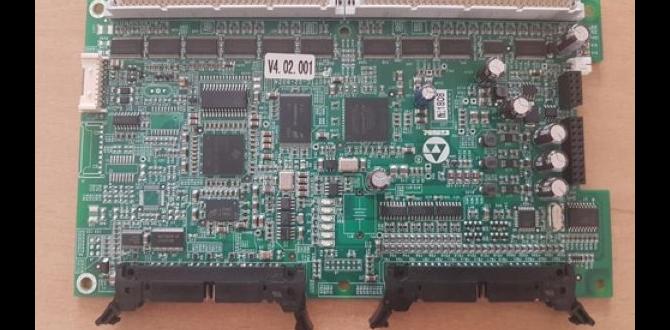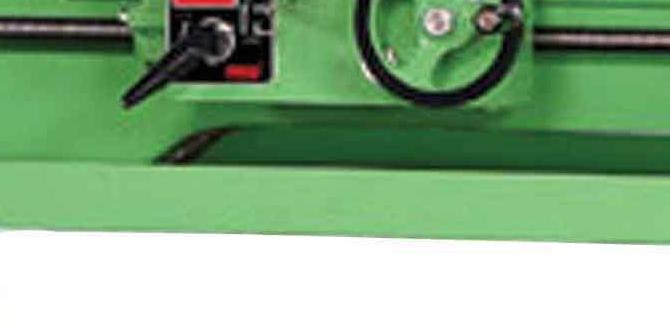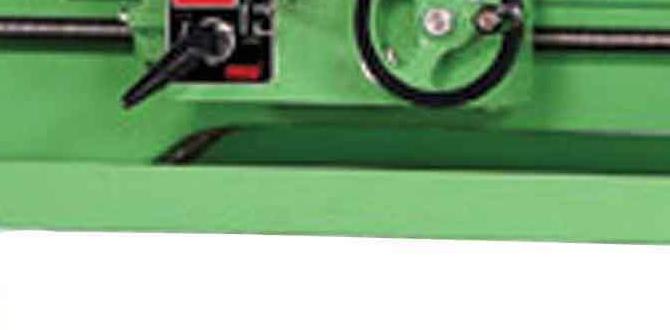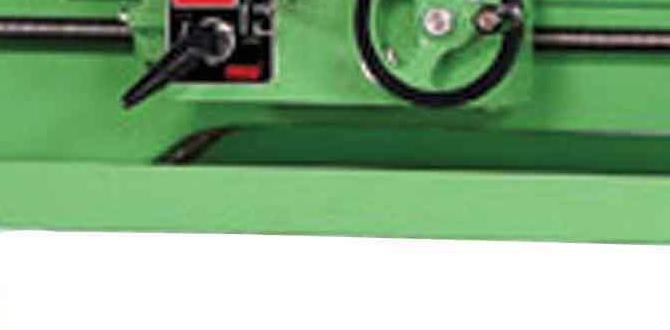Quick Summary
Transform your drill press into a versatile mini-lathe with a drill press lathe attachment! This essential power tool upgrade lets you shape and turn wood or soft metals, expanding your workshop capabilities without a dedicated lathe. Learn how to choose, install, and safely use this affordable solution for DIY projects and intricate detailing.
Ever wished you could shape wood or metal with more precision right in your own workshop, but felt that a full-sized lathe was out of reach? You’re not alone! Many DIY enthusiasts and aspiring makers face this common challenge. The good news is, you don’t need a dedicated, expensive lathe to start turning. There’s an ingenious attachment designed specifically to outfit your drill press for lathe work. It’s a game-changer for small projects, repairs, and adding those special touches to your creations. We’ll walk you through everything you need to know, from picking the right attachment to using it a safe and effective way. Get ready to unlock a new level of precision and creativity in your home workshop!
Unlocking Lathe Capabilities: The Drill Press Attachment Advantage
A drill press is a staple in many workshops, known for its precision drilling capabilities. But what if you could harness its power for something more? Enter the lathe attachment for a drill press. This clever device essentially converts your drill press into a rudimentary lathe, opening up a world of possibilities for shaping and refining workpieces. Think of it as a clever hack that leverages existing tools to achieve new functions, making it an incredibly economical and space-saving solution for hobbyists.
For beginners, the idea of operating a lathe can seem daunting. Lathes involve spinning workpieces at controlled speeds while carefully shaping them with cutting tools. A drill press attachment simplifies this process significantly. It allows you to experience the core principles of lathe work – rotating material and precise cutting – in a more controlled and approachable environment. This means you can create cylindrical shapes, turn down dowels, carve decorative elements, or even perform simple metal turning tasks without investing in a full-blown lathe machine.
Why Consider a Drill Press Lathe Attachment?
- Affordability: Compared to purchasing a dedicated metal or woodworking lathe, a drill press attachment is significantly less expensive. This makes it an ideal entry point for those on a budget.
- Space-Saving: If workshop space is limited, a drill press attachment is a brilliant solution. It allows you to perform lathe-like operations without dedicating a large footprint to a separate machine.
- Learning Curve: The operation is generally simpler than a full lathe, making it easier for beginners to grasp the fundamental concepts of turning and shaping.
- Versatility: While not as robust as a dedicated lathe, these attachments are surprisingly capable for a wide range of tasks, especially in woodworking and for light metalworking.
- Existing Tool Leverage: You’re using a tool you likely already own, making the upgrade more practical and less of an entirely new investment.
Understanding the Components of a Drill Press Lathe Attachment
While designs can vary, most drill press lathe attachments share key components that enable their function. Understanding these parts will help you choose the right one and operate it safely and effectively.
Key Components:
- Headstock & Spindle: This is where the workpiece mounts. It connects to your drill press chuck, causing the workpiece to spin. Some models might have their own integrated spindle with a chuck or Morse taper.
- Tailstock: This part typically houses a center or a drill bit holder, which supports the other end of the workpiece and helps keep it stable and aligned as it spins.
- Tool Rest: A crucial element for safety and precision. It’s an adjustable angled surface where you’ll rest your cutting tools (chisels, gouges, etc.) for controlled shaping.
- Base or Clamp System: This part attaches the entire unit securely to your drill press table, ensuring it doesn’t move during operation.
- Drive System: This is how the rotation from your drill press spindle is transferred to the workpiece. Usually, this involves the drill press chuck gripping the attachment’s spindle.
The quality of these components, especially the bearings in the headstock and tailstock, can greatly affect the smoothness of operation and the longevity of the attachment. Higher-quality attachments will often feature more robust materials and better-engineered parts for improved performance.
| Feature | Woodworking Focus | Metalworking Lighter Duty | Hybrid/General Purpose |
|---|---|---|---|
| Primary Material | Wood | Soft metals (aluminum, brass, sometimes mild steel) | Wood & soft metals |
| Spindle Speed Range | Lower speeds are often sufficient (500-2000 RPM) | Can require higher speeds, but controlled RPM is key | Variable, depending on material |
| Tool Rest Rigidity | Moderate to High | High, to handle metal cutting forces | Moderate to High |
| Chuck/Mounting Options | Often simple chucks or custom jigs | Preferably Morse taper or robust chucks | Often standard chucks or adaptable mounts |
| Typical Price Range | $$ – $$$ | $$$ – $$$$ | $$ – $$$$ |
| Power Requirements | Drill press motor | Drill press motor (higher HP recommended for metal) | Drill press motor |
Choosing the Right Lathe Attachment for Your Drill Press
With several options on the market, selecting the best drill press lathe attachment for your specific needs is important. Consider what you plan to make and what type of material you’ll be working with.
Factors to Consider:
- Material Type: Are you primarily working with wood, or do you intend to tackle softer metals like aluminum or brass? Woodworking attachments might have lighter-duty components, while metal turning requires more rigid construction and potentially higher torque from your drill press.
- Drill Press Capacity: Ensure the attachment is compatible with your drill press. Check the maximum workpiece length and diameter it can handle, as well as the size of the drill press table it attaches to. Your drill press’s horsepower is also a factor, especially if you plan to turn metal, which requires more power.
- Build Quality and Material: Look for attachments made from sturdy materials like cast iron or thick steel. Check reviews for information on bearing quality and overall rigidity. A wobbly tool rest or a loose spindle will lead to frustration and potential safety hazards.
- Ease of Setup and Use: Some attachments are quick to install and adjust, while others might require more tinkering. For beginners, a simpler setup is usually better.
- Included Accessories: Does the attachment come with a basic tool rest, a center point, or even a small chuck? These can be valuable additions.
- Budget: Prices can range from under $100 for basic woodworking models to several hundred dollars for more robust metalworking versions.
It’s often a good idea to check out reviews from other users and watch comparison videos online. This can give you a real-world perspective on how different attachments perform. Resources like woodworking forums or machining communities can also be invaluable for getting recommendations from experienced users.
Safety First: Essential Precautions for Using Your Attachment
Safety is paramount whenever operating any power tool, and using a drill press as a makeshift lathe is no exception. Always remember: your hands and eyes are your most valuable tools, so protect them!
Critical Safety Guidelines:
- Secure the Attachment: Ensure the lathe attachment is clamped firmly to your drill press table. Any movement during operation can be dangerous. Double-check the clamps before starting.
- Mount the Workpiece Securely: Whether you’re using a chuck, a spur drive, or a faceplate, make sure the workpiece is mounted as securely as possible. A workpiece flying off the lathe is a serious hazard.
- Proper Tool Rest Placement: The tool rest should be positioned close to the workpiece – typically no more than a 1/8-inch gap. It should also be slightly below the centerline of the workpiece. This prevents the cutting tool from digging in and catching.
- Use Sharp Tools: Dull tools require more force, making them harder to control and increasing the risk of kickback. Keep your chisels and gouges sharp.
- Wear Safety Gear: Always wear safety glasses or a face shield. A dust mask is also recommended, especially when working with wood. Avoid loose clothing, jewelry, or long hair that could get caught in the spinning workpiece.
- Start Slow: Begin with the drill press set to its lowest speed setting. Gradually increase speed as you become more comfortable and as cutting demands require. Avoid sudden changes in speed.
- Feed Rate: Don’t try to remove too much material at once. Use a steady, controlled feed rate. Let the tool do the work without forcing it.
- Never Turn Off the Drill Press While Cutting: Always finish your cut and then stop the tool before turning off the drill press motor.
- Understand Kickback: Kickback is when the tool suddenly jerks or the workpiece is thrown. Proper tool rest setup, sharp tools, and controlled cuts significantly reduce the risk.
- Disconnect Power: Always unplug or disconnect the power to your drill press before making any adjustments, changing tools, or cleaning the attachment.
Familiarize yourself with the specific safety features and recommendations for both your drill press and the lathe attachment you’ve purchased. Consulting guides from organizations like the Occupational Safety and Health Administration (OSHA) regarding safe machine operation can also provide valuable insights. For instance, OSHA’s General Industry Standard on Machine Guarding (29 CFR 1910.212) outlines the fundamental requirements for preventing injuries from machine hazards.
Setting Up Your Drill Press Lathe Attachment: Step-by-Step
Getting your drill press ready for lathe work is usually a straightforward process. Follow these steps to ensure a safe and effective setup.
Installation Steps:
- Prepare Your Drill Press: Make sure your drill press table is clean and free of debris. Remove any auxiliary jigs or fixtures that might be in the way.
- Position the Attachment: Place the lathe attachment onto the drill press table. The base of the attachment should sit flat and stable.
- Align the Headstock: Position the headstock of the attachment so that it will be directly under the drill press spindle.
- Secure the Base: Use the clamps provided with the attachment, or your own appropriate clamps, to firmly secure the attachment’s base to the drill press table. Ensure it cannot shift or slide.
- Mount the Drive Mechanism: If your attachment uses a direct drive spindle, insert it into your drill press chuck. If it has its own chuck, ensure it’s tightened onto the attachment’s spindle.
- Set Up the Tailstock: Position the tailstock opposite the headstock, aligned with the spindle. The tailstock’s center point should in line with the eventual workpiece center. Some attachments have a sliding tailstock, others a fixed one.
- Install the Tool Rest: Attach the tool rest to its post and position it at the desired height and angle. For initial setup, place it close to the headstock, ready for receiving the workpiece. Remember the rule: slightly below centerline, and no more than 1/8-inch gap.
- Tension the Belt (if applicable): Some drill presses have belt-driven speed adjustments. Ensure the belts are properly tensioned.
- Engage the Drill Press Chuck: Close the drill press chuck securely around the attachment’s spindle or drive stub.
- Check for Play: Gently try to wiggle the attachment and workpiece mounting points. There should be no significant play or looseness.
Once set up, you’ll want to test the rotation. With the drill press unplugged, manually turn the drill press spindle to ensure everything moves freely and is aligned. Then, plug in the drill press, set it to its lowest speed, and carefully operate the drill press to confirm the attachment spins true.
Using Your Drill Press Lathe Attachment: Basic Techniques
Now that your attachment is set up, it’s time to learn some basic techniques for shaping your workpiece.
Wood Turning Basics:
Woodworking is the most common application for drill press lathe attachments. You’ll typically use specialized woodturning chisels and gouges.
- Mounting Wood: You can mount wood in a variety of ways:
- Between Centers: For longer pieces, use a spur drive center in the headstock and a live or dead center in the tailstock.
- In a Chuck: If your attachment has a chuck, you can grip the wood directly (for smaller pieces) or use faceplates.
- Faceplate: A faceplate screws onto the headstock spindle and allows you to attach larger, flatter workpieces.
- Roughing a Cylinder: Start with a roughly shaped piece of wood (e.g., a square blank). Set your tool rest close and angled slightly. Using a roughing gouge, with the bevel rubbing against the tool rest, begin to shape the wood into a cylinder from the center outwards.
- Beading and Parting: Use a parting tool (a narrow, sharp chisel) to create grooves or to cut a piece off. Beading involves using a small gouge to create decorative rounded sections.
- Scraping: For finer finishes, especially in hardwoods, scraping with specific scraping tools can be very effective.
- Sanding: Once you have the desired shape, you can often sand directly on the lathe. Start with coarser grit sandpaper and move to finer grits. Hold the sandpaper gently against the spinning wood. Do not wrap sandpaper around the workpiece!
Light Metal Turning Basics:
For metal, you’ll need a more robust attachment and a drill press with sufficient power and a wide speed range. Metal turning requires different tools and techniques.
- Mounting Metal: Metal pieces are almost always mounted securely in a chuck. For longer pieces, a sturdy tailstock center is essential.
- Using Metal Turning Tools: Specialized metal turning tools (like HSS or carbide bits) are used. These are typically held in a tool post or clamped down for rigidity.
- Cutting Speed: Metal requires much slower speeds than wood. You’ll need to find the optimal RPM for your specific metal and tool. Tools like the Massachusetts Department of Labor Standards minimum safety requirements for machinery offer insights into the importance of safeguarding and controlled operation, which translates to careful speed selection.
- Lubrication: Using cutting fluid or oil is often necessary to cool the tool and workpiece, and to improve the finish.
- Feed: Metal turning typically involves controlled feeding of the cutting tool into the workpiece.
Remember, metal turning is more demanding. Always ensure your drill press has enough power, that the attachment is exceptionally rigid, and that you understand the safety implications of working with metal. For beginners, focusing on wood first is often recommended.
Troubleshooting Common Issues
Even with the best setup, you might encounter a few snags along the way. Here are some common problems and their solutions:
Common Problems & Solutions:
- Workpiece Wobbles:
- Cause: Loose mounting, bent spindle, unbalanced workpiece, or improper tailstock alignment.
- Solution: Re-secure the workpiece in the chuck or on the centers. Ensure the tailstock center is perfectly aligned. Check for any bends in the attachment’s spindle or the drill press spindle. Try to balance the workpiece.
- Chatter or Vibration:
- Cause: Dull cutting tool, tool rest too far away, too fast a feed rate, or a loose attachment.
- Solution: Sharpen your cutting tools. Move the tool rest closer to the workpiece (but not touching unless cutting specified). Slow down your feed rate. Ensure the attachment is securely clamped to the drill press table.
- Tool Catches or Tears into Wood:
- Cause: Bevel digging in instead of rubbing, tool rest too high, or attempting to take too deep a cut.
- Solution: Ensure the bevel of your gouge is rubbing on the tool rest. Lower the tool rest if it’s too high. Make lighter, more controlled cuts.
- Attachment Feels Loose:
- Cause: Insufficient clamping, worn clamps, or warped drill press table.
- Solution:






